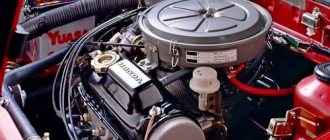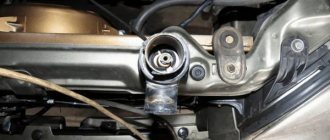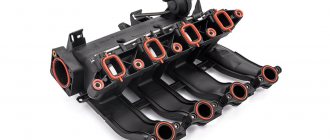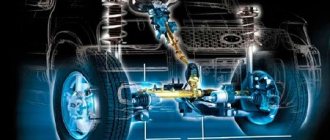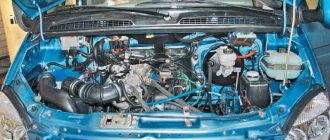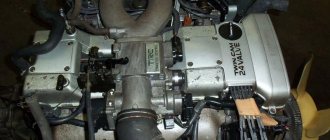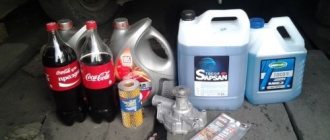The main purpose of the engine lubrication system
Oil not only ensures the proper operation of the moving mechanical parts of the power unit, but is also responsible for cooling the engine. Today, in modern engines that operate at maximum load, it is the lubrication system that allows for trouble-free operation of the power unit. There are increased demands on oil quality, so most modern engines use synthetic compounds that are durable, capable of operating under significant loads and retain their performance characteristics for a long time. The lubrication system itself operates with increased pressure, which allows the working fluid to be quickly pumped through the engine, ensuring its lubrication and rapid cooling.
High-quality synthetic oil creates a thin film on the moving parts of the engine that reduces friction, provides cooling and quickly removes wear products. Without such high-quality cooling, the engine will quickly overheat, and without a thin film, friction increases significantly, which leads to increased wear of parts. That is why due attention must be paid to the quality of the oil itself and the correct operation of the lubrication system.
This lubrication system consists of the following components:
- 1. Filters.
- 2. Oil pump.
- 3. Pallet.
- 4. Channels through which the working fluid moves.
Built-in sensors monitor both oil temperature and system pressure, which allows you to identify possible problems with the lubrication system. Most modern engines also have an additional radiator for oil cooling, which can significantly reduce the operating temperature of the fluid, improving engine cooling. The pump can be driven using a belt or chain. In recent years, the most popular has become the chain drive, which is extremely durable, durable and does not require any maintenance during operation.
Lubrication system malfunctions
The main malfunctions of the car engine lubrication system are expressed in changes in pressure in the system. Modern cars have appropriate sensors that make it possible to detect such a change in pressure, and issue a corresponding warning about the presence of a breakdown on the dashboard or on-board computer screen.
Operating a car with problems with the lubrication system is not recommended, as this leads to rapid wear of the power unit and the appearance of breakdowns, the elimination of which will require expensive major repairs. That is why, at the first sign of a malfunction in the lubrication system and when a corresponding warning appears, it is necessary to transport the car on a tow truck to a service center and repair the existing breakdowns. This will significantly reduce the cost of operating and repairing the machine.
Clogging of fine and coarse oil filters can also lead to certain failures and malfunctions of the lubrication system. That is why, when characteristic symptoms appear, you should first check the condition of the filters, which may become clogged, which leads to oil starvation of the engine. In this case, the repair consists of replacing the oil and filter elements, which allows you to solve existing problems.
On engines whose mileage exceeds 100,000 kilometers, problems appear in the operation of the lubrication system, which are caused by clogging of the crankcase ventilation. Such breakdowns are typical for powerful six-cylinder engines, which are subject to increased load during operation, which leads to malfunctions. Repair of the lubrication system in this case consists of replacing the corresponding ventilation system, which can be changed along with the valve cover.
Special lubrication system designs
There are so-called dry sump engines. In them, oil is not poured into the crankcase, but into a separate container connected to a closed system line.
Typically this design is used in racing and sports cars. The fact is that under strong lateral loads (high-speed turns), the lubricant is pressed against the walls under the influence of centrifugal force, and the intake grabs air.
A separate container saves the situation, since the bottom area has equal proportions to the height.
As can be seen in the diagram: even when tilted, the liquid does not fall below the level of the intake tube.
We use high-quality oil and change it on time
Using low-quality oil or not carrying out maintenance work in a timely manner also leads to problems with engine lubrication. The problem-free operation of the power unit often depends on the quality of the engine oil. When using low-quality lubricant, foreign deposits appear, the engine becomes coked, and oil starvation occurs, which ultimately leads to the need for a major overhaul of the engine. That is why you should fully comply with the requirements of car manufacturers regarding the oil tolerance used and carry out regular service work on the car engine.
How to prevent engine lubrication failures?
Without a doubt, the best way to avoid car engine lubrication problems is to keep preventative maintenance up to date. Damage caused by improper lubrication is often much more costly to a vehicle owner than an oil change—not to mention much more difficult to repair.
Oil changes should be carried out in accordance with the operating conditions of the vehicle, this information is contained in the owner's manual and is divided into normal and severe conditions of use.
For normal operating conditions, as a rule, the period specified by the engine manufacturer is 10 thousand km or every 12 months on newer vehicles.
That is, even if the vehicle has covered less than 10 thousand km in 12 months, it is necessary to change the oil. If the car is used under difficult operating conditions, the exchange period is halved.
Like any chemical, auto lubricating oil has an expiration date. This is why the product must be replaced within this period of time to ensure engine lubrication.
It is also important to choose the right type of engine lubricant for your vehicle. For example, the manufacturer's manual, usually available online, may contain details of the appropriate SAE viscosity.
Engine design features as a cause of lubrication system failure
In some cases, the cause of problems with the engine lubrication system is the design features of the power unit. For example, some powerful engines have turbines located in the camber of the cylinder block, which leads to a significant increase in engine temperature. As a result, the oil quickly becomes coked, insufficient pressure appears in the system, and, consequently, engine wear increases, which will soon require major repairs. For certain modifications of power units, it is for this reason that expensive major repairs are required every 100,000 kilometers.
Lubrication system maintenance
The process can be done in different ways, depending on the size of the problem.
- One-time hard cleaning: in fact, flushing the engine lubrication system. It is carried out in case of a slight drop in pressure, or insufficient operation of the hydraulic compensators. The old oil is drained and the engine is filled with a special flushing fluid (with a new filter). After running the engine for a short time (recommendations are in the flushing instructions), the liquid is drained, the filter is changed, and fresh oil is added. The first replacement interval is reduced by at least half, since there may be a large amount of undissolved sludge inside.
- Long lasting gentle cleaning. For this purpose, motor oil with a high percentage of detergent additives is used. Or such additives are added to the usual lubricant. Most often, the lubrication system of a diesel engine is washed this way, due to the high soot content during its operation.
- Mechanical cleaning. Performed during a major engine overhaul. The unit is disassembled, the oil channels and the internal walls of the crankcase are cleaned. It is advisable to replace or at least rebuild the oil pump.
Engine lubrication system repair
Let us tell you in more detail about the malfunctions of the lubrication system and how to eliminate them. Such repairs present certain difficulties, so in most cases it is not possible to carry out such repairs yourself. To eliminate such malfunctions, specialists will need to open the engine, determine the cause of the malfunction of the engine lubrication system, and replace the failed components and assemblies. The cost of repairs will vary in each specific case. So, for example, if the cause of the breakdown is a clogged filter, then such repairs will have an affordable cost. But if, due to oil starvation, the piston group wears out or the crankshaft is jammed, then such repairs will be almost comparable in cost to buying a new engine.
As you can see, troubleshooting such engine lubrication system problems is difficult and expensive. That is why it is necessary to regularly carry out appropriate maintenance work, change the oil and use only lubricants approved by the manufacturer. This will prevent such breakdowns and reduce the car owner’s costs of operating his car. If the first signs of a malfunction in the lubrication system appear, it is not recommended to delay repairs. The sooner you contact the appropriate service stations, the easier and cheaper it is to fix such a breakdown.
27.09.2017

